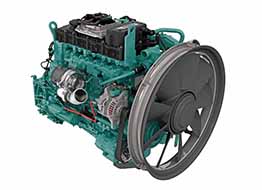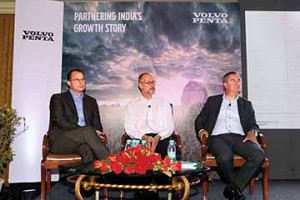
Porträtt på
Beställare: Hanna Johansen.
Bild: Cicci Jonson, Bilduppdraget.
Volvo Penta will source five and eight-litre engines locally to better address the needs of the market.
Story by: Bhargav TS
Swedish engine maker Volvo Penta will source five and eight litre engines locally from the Group manufacturing plant of Volvo Eicher Powertrain (VEPT) from next year. The engines will be aimed at the domestic market, and would roll out of a separate line set up at the VEPT plant at Pithampur near Indore. The VEPT plant is part of the Volvo Eicher Commercial Vehicle joint venture, and works as a common manufacturing base for Volvo’s D5 and D8 engines. The development to manufacture the D5 and D8 engines locally spells a big opportunity for Volvo Penta, which has been supplying engines for industrial and marine applications in India since the last two decades. “We see a great opportunity in the infrastructure development in the country. As the demand from customers is increasing constantly, there is pressure on contractors to complete projects on schedule at cost levels they have calculated. So there is need for highly reliable and fuel efficient equipment to meet these demands. The ability to supply engines quickly is a key capability for Volvo Penta,” said Jonas Nilsson, Head of Volvo Penta India. He added, “Our engines enable OEMs to make their products more competitive in the domestic and global markets, as well as to explore the global market.”
Finding use in a variety of Volvo Group products including trucks, the D5 and D8 engines, have been finding use locally as well as internationally. Used in Volvo machines that serve fields like construction, material handling, raw material exploration and agriculture, the five-and eight- litre engine that Volvo Penta will offer would be certified for Bharat (CEV) Stage III emissions standards, which are equivalent to EU stage IIIA/Tier 3. To enable the company to address the local market needs, the D5 and D8 engine share the electronics platform with the bigger D11, D13, and D16 engine platforms. This allows the company to communicate using the same protocol, simplifying design work for OEMs. The engines – an inline four cylinder and six cylinder design, make for a common design footprint. They also make the design process easier for several emission stages. Expressed Volvo Penta’s Senior Vice President, Global Operations and Quality, Peter Hertinge, that the Pithampur plant is one of the most modern engine production facilities in India; is highly automated with integrated testing facilities. “It has quality standards and procedures in place to produce engines that are suitable for customer requirements and are able to meet the latest and most stringent emission regulations,” he added.
While most engine manufacturers have incorporated exhaust gas recirculation (EGR) into their Bharat Stage III models, Volvo Penta engineered its D5 and D8 engines to burn clean enough to not need the addition of an EGR. The benefits of the engine’s highly efficient fuel injection system include less upkeep and maintenance, as well as better fuel consumption and good low-end response. Averred Bjorn Ingemanson, President of Volvo Penta, “The (Volvo Penta) division has been exploring ways to leverage fully its investment at VEPT in the future. One of Volvo Penta’s global ambitions is to create a premium supply chain for our products with competitive lead times at a competitive cost. Introducing production in India will help us to lay the foundation on which we will build our future. We see great value in expanding upon our knowledge gained by working with OEMS in the country, and we look forward to putting that into practice for the benefit of our Indian customers.”
Box:
Q. What do you think of the quality of components in India, that you will procure engines locally?
A. We have a fully globalised processing function. We do common sourcing, and this applies to the quality of the parts sourced as well. When we start our New Product Development (NPD) we look at our sourcing pattern as a global activity to identify the best suppliers regardless of where they are located. In the last two years the sourcing of components from India to the global supply chain is growing in terms of NPD and also in terms of operational flow.
Q. When you say the share of business has grown, is there some way of quantifying it?
A. Typically we don’t disclose the footprint of our global sourcing activity. What I would say therefore is that it is increasing. The engines that we will be sourcing from next year already have a fair amount of local content in them. It is a reflection of the fact that sourcing from India is at the forefront of Volvo Penta’s activities.
Q. What would be the localisation level of 5- and 8-litre engines that you would source locally?
A. We will be having a high degree of localisation of components to start with. In the first phase of the localisation, attention would be on production. We will keep the current sourcing pattern going. We will tweak the logistics differently because it goes to different factories. What I am thinking about is the contribution of the Indian market towards the total supply chain in terms of the incremental benefit in volumes.
Q. How do the engines meet stringent emission norms without an EGR?
A. Emission legislation requires engines that are more and more complex. We also see a trend where every manufacturer, including us, tries to meet the new legislations in as simple a manner as possible. With the high quality of our combustion cycle we have achieved a good air treatment solution. We are therefore able to meet the standards without including an EGR. Apart from affecting the cost of the product, there is an effect on the product as well. An engine is that much less complex too.
Q. What are all the challenges that you see in the Indian market?
A. From the product perspective it is always necessary to balance between, or manage a mix of performance and best fulfilling the intended use of the engine. When launching a new platform or localising production, it is necessary to adapt towards meeting the demand of every single customer. It is necessary to accordingly tune the engine to fit the product needs.
Q. What have been the learnings from the Indian operations?
A. The learnings include both sourcing and R&D. On both the counts, we stand to benefit from the diversity and versatility of understanding the needs of our customers. These vary according to the market; are different for different markets. Balancing the globalisation benefits in order to adapt to the local needs of every market is the main learning we have had from the Indian market.
Q. Do you think an alternate fuel can play a role here in India?
A. I think it can, but I haven’t seen a robust trend so far. I think, an alternate fuel has to bring benefits from a 360-degree perspective. There is a need to optimise; to prepare for the complete cycle. It is challenging with many future alternate fuels. From the products perspective, we can develop any kind of engine. The challenge is however to look at alternate fuel propulsion holistically.





















